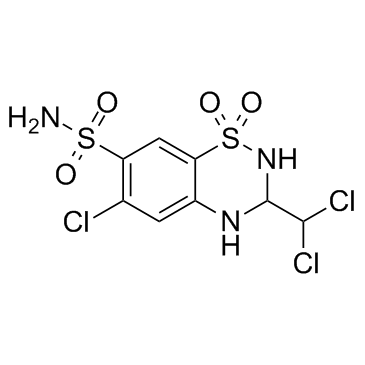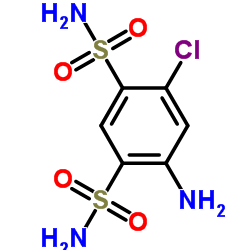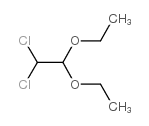133-67-5
| 中文名 | 三氯噻嗪 |
|---|---|
| 英文名 | Trichlormethiazide |
| 中文别名 | 6-氯-3-(二氯甲基)-3,4-二氢-7-氨基磺酰基-1,2,4-苯并噻二嗪-1,1-二氧化物 |
| 英文别名 |
2H-1,2,4-Benzothiadiazine-7-sulfonamide, 6-chloro-3-(dichloromethyl)-3,4-dihydro-, 1,1-dioxide
Metahydrin 6-chloro-3-(dichloromethyl)-1,1-dioxo-3,4-dihydro-2H-1λ<sup>6</sup>,2,4-benzothiadiazine-7-sulfonamide Trichloromethiazide Diu-Hydrin Esmarin Triflumen Achletin,Diu-Hydrin,Triflumen Carvacron Diurese MFCD00057315 Achletin Salurin Tolcasone Kubacron 6-Chloro-3-(dichloromethyl)-3,4-dihydro-2H-1,2,4-benzothiadiazine-7-sulfonamide 1,1-dioxide Anatran Flutra Trichlormethiazide Naqua EINECS 205-118-8 Anistadin Tachionin 3-Dichloromethyl-6-chloro-7-sulfamoyl-3,4-dihydro-1,2,4-benzothiadiazine-1,1-dioxide Fluitran 6-Chloro-3-dichloromethyl-3,4-dihydro-2H-1,2,4-benzothiadiazine-7-sulfonamide 1,1-Dioxide |
| 描述 | Trichlormethiazide是噻嗪类利尿剂。 |
|---|---|
| 相关类别 | |
| 参考文献 |
| 密度 | 1.7±0.1 g/cm3 |
|---|---|
| 沸点 | 631.3±65.0 °C at 760 mmHg |
| 熔点 | 248-250ºC |
| 分子式 | C8H8Cl3N3O4S2 |
| 分子量 | 380.656 |
| 闪点 | 335.6±34.3 °C |
| 精确质量 | 378.902191 |
| PSA | 135.12000 |
| LogP | 0.24 |
| 外观性状 | 白色-类白色晶体-粉末 |
| 蒸汽压 | 0.0±1.8 mmHg at 25°C |
| 折射率 | 1.625 |
| 储存条件 | 室温 |
| 分子结构 | 1、 摩尔折射率:76.97 2、 摩尔体积(cm3/mol):217.6 3、 等张比容(90.2K):607.1 4、 表面张力(dyne/cm):60.5 5、 极化率(10-24cm3):30.51 |
| 计算化学 | 1.疏水参数计算参考值(XlogP):无 2.氢键供体数量:3 3.氢键受体数量:7 4.可旋转化学键数量:2 5.互变异构体数量:无 6.拓扑分子极性表面积135 7.重原子数量:20 8.表面电荷:0 9.复杂度:571 10.同位素原子数量:0 11.确定原子立构中心数量:0 12.不确定原子立构中心数量:1 13.确定化学键立构中心数量:0 14.不确定化学键立构中心数量:0 15.共价键单元数量:1 |
|
Section1. IDENTIFICATION OF THE SUBSTANCE/MIXTURE Product identifiers Product name: Trichlormethiazide CAS-No.: 133-67-5 Relevant identified uses of the substance or mixture and uses advised against Identified uses: Laboratory chemicals, Manufacture of substances Section2. HAZARDS IDENTIFICATION Classification of the substance or mixture Classification according to Regulation (EC) No 1272/2008 [EU-GHS/CLP] Respiratory sensitization (Category 1) Skin sensitization (Category 1) Classification according to EU Directives 67/548/EEC or 1999/45/EC May cause sensitization by inhalation and skin contact. Label elements Labelling according Regulation (EC) No 1272/2008 [CLP] Pictogram Signal wordDanger Hazard statement(s) H317May cause an allergic skin reaction. H334May cause allergy or asthma symptoms or breathing difficulties if inhaled. Precautionary statement(s) P261Avoid breathing dust/ fume/ gas/ mist/ vapours/ spray. P280Wear protective gloves. P342 + P311If experiencing respiratory symptoms: Call a POISON CENTER or doctor/ physician. Supplemental Hazardnone Statements According to European Directive 67/548/EEC as amended. Hazard symbol(s) R-phrase(s) R42/43May cause sensitization by inhalation and skin contact. S-phrase(s) S36Wear suitable protective clothing. Other hazards Photosensitizer. Section3. COMPOSITION/INFORMATION ON INGREDIENTS Substances Formula: C8H8Cl3N3O4S2 Molecular Weight: 380,66 g/mol ComponentConcentration Trichlormethiazide CAS-No.133-67-5- EC-No.205-118-8 Section4. FIRST AID MEASURES Description of first aid measures General advice Consult a physician. Show this safety data sheet to the doctor in attendance. If inhaled If breathed in, move person into fresh air. If not breathing, give artificial respiration. Consult a physician. In case of skin contact Wash off with soap and plenty of water. Consult a physician. In case of eye contact Flush eyes with water as a precaution. If swallowed Never give anything by mouth to an unconscious person. Rinse mouth with water. Consult a physician. Most important symptoms and effects, both acute and delayed Muscle cramps/spasms., Anorexia., Weakness, Central nervous system depression, Dermatitis, Nausea, Dizziness, Headache, Vomiting, Diarrhoea Indication of any immediate medical attention and special treatment needed no data available Section5. FIREFIGHTING MEASURES Extinguishing media Suitable extinguishing media Use water spray, alcohol-resistant foam, dry chemical or carbon dioxide. Special hazards arising from the substance or mixture Carbon oxides, nitrogen oxides (NOx), Sulphur oxides, Hydrogen chloride gas Advice for firefighters Wear self contained breathing apparatus for fire fighting if necessary. Further information no data available Section6. ACCIDENTAL RELEASE MEASURES Personal precautions, protective equipment and emergency procedures Use personal protective equipment. Avoid dust formation. Avoid breathing vapors, mist or gas. Ensure adequate ventilation. Evacuate personnel to safe areas. Avoid breathing dust. Environmental precautions Do not let product enter drains. Methods and materials for containment and cleaning up Pick up and arrange disposal without creating dust. Sweep up and shovel. Keep in suitable, closed containers for disposal. Reference to other sections For disposal see section 13. Section7. HANDLING AND STORAGE Precautions for safe handling Avoid contact with skin and eyes. Avoid formation of dust and aerosols. Provide appropriate exhaust ventilation at places where dust is formed.Normal measures for preventive fire protection. Conditions for safe storage, including any incompatibilities Store in cool place. Keep container tightly closed in a dry and well-ventilated place. Specific end uses no data available Section8. EXPOSURE CONTROLS/PERSONAL PROTECTION Control parameters Components with workplace control parameters Exposure controls Appropriate engineering controls Handle in accordance with good industrial hygiene and safety practice. Wash hands before breaks and at the end of workday. Personal protective equipment Eye/face protection Face shield and safety glasses Use equipment for eye protection tested and approved under appropriate government standards such as NIOSH (US) or EN 166(EU). Skin protection Handle with gloves. Gloves must be inspected prior to use. Use proper glove removal technique (without touching glove's outer surface) to avoid skin contact with this product. Dispose of contaminated gloves after use in accordance with applicable laws and good laboratory practices. Wash and dry hands. The selected protective gloves have to satisfy the specifications of EU Directive 89/686/EEC and the standard EN 374 derived from it. Body Protection Complete suit protecting against chemicals, The type of protective equipment must be selected according to the concentration and amount of the dangerous substance at the specific workplace. Respiratory protection For nuisance exposures use type P95 (US) or type P1 (EU EN 143) particle respirator.For higher level protection use type OV/AG/P99 (US) or type ABEK-P2 (EU EN 143) respirator cartridges. Use respirators and components tested and approved under appropriate government standards such as NIOSH (US) or CEN (EU). Section9. PHYSICAL AND CHEMICAL PROPERTIES Information on basic physical and chemical properties a) AppearanceForm: solid b) Odourno data available c) Odour Thresholdno data available d) pHno data available e) Melting point/freezingno data available point f) Initial boiling point and no data available boiling range g) Flash pointno data available h) Evaporation rateno data available i) Flammability (solid, gas) no data available j) Upper/lowerno data available flammability or explosive limits k) Vapour pressureno data available l) Vapour densityno data available m) Relative densityno data available n) Water solubilityno data available o) Partition coefficient: n- no data available octanol/water p) Autoignitionno data available temperature q) Decompositionno data available temperature r) Viscosityno data available s) Explosive propertiesno data available t) Oxidizing propertiesno data available Other safety information no data available Section10. STABILITY AND REACTIVITY Reactivity no data available Chemical stability no data available Possibility of hazardous reactions no data available Conditions to avoid no data available Incompatible materials no data available Hazardous decomposition products Other decomposition products - no data available Section11. TOXICOLOGICAL INFORMATION Information on toxicological effects Acute toxicity LD50 Oral - rat - 5.600 mg/kg Skin corrosion/irritation no data available Serious eye damage/eye irritation no data available Respiratory or skin sensitization no data available May cause allergic respiratory and skin reactions Germ cell mutagenicity Genotoxicity in vitro - Hamster - Lungs Cytogenetic analysis Genotoxicity in vitro - Hamster - fibroblast Cytogenetic analysis Carcinogenicity IARC:No component of this product present at levels greater than or equal to 0.1% is identified as probable, possible or confirmed human carcinogen by IARC. Reproductive toxicity no data available Specific target organ toxicity - single exposure no data available Specific target organ toxicity - repeated exposure no data available Aspiration hazard no data available Potential health effects InhalationMay be harmful if inhaled. May cause respiratory tract irritation. IngestionMay be harmful if swallowed. SkinMay be harmful if absorbed through skin. May cause skin irritation. EyesMay cause eye irritation. Signs and Symptoms of Exposure Muscle cramps/spasms., Anorexia., Weakness, Central nervous system depression, Dermatitis, Nausea, Dizziness, Headache, Vomiting, Diarrhoea Additional Information RTECS: DK8925000 Section12. ECOLOGICAL INFORMATION Toxicity no data available Persistence and degradability no data available Bioaccumulative potential no data available Mobility in soil no data available Results of PBT and vPvB assessment no data available Other adverse effects no data available Section13. DISPOSAL CONSIDERATIONS Waste treatment methods Product Offer surplus and non-recyclable solutions to a licensed disposal company. Contact a licensed professional waste disposal service to dispose of this material. Dissolve or mix the material with a combustible solvent and burn in a chemical incinerator equipped with an afterburner and scrubber. Contaminated packaging Dispose of as unused product. Section14. TRANSPORT INFORMATION UN number ADR/RID: -IMDG: -IATA: - UN proper shipping name ADR/RID: Not dangerous goods IMDG: Not dangerous goods IATA:Not dangerous goods Transport hazard class(es) ADR/RID: -IMDG: -IATA: - Packaging group ADR/RID: -IMDG: -IATA: - Environmental hazards ADR/RID: noIMDG Marine pollutant: noIATA: no Special precautions for user no data available SECTION 15 - REGULATORY INFORMATION N/A SECTION 16 - ADDITIONAL INFORMATION N/A |
|
毒理学数据: 急性毒性数据: 男人经口TDLo:3320 ug/kg/7W-I 大鼠经口LD50:5600mg/kg 大鼠静脉LD50:920mg/kg 小鼠经口LD50:2600mg/kg 小鼠腹腔LD50:540mg/kg 小鼠静脉LD50:750mg/kg 其他多剂量数据: 哺乳动物狗TDLo:182mg/kg/1Y-I 致突变数据: 啮齿动物-仓鼠成纤维细胞:750mg/L 啮齿动物-仓鼠肺:560mg/L CHEMICAL IDENTIFICATION
HEALTH HAZARD DATAACUTE TOXICITY DATA
MUTATION DATA
|
| 符号 |

GHS08 |
|---|---|
| 信号词 | Danger |
| 危害声明 | H317-H334 |
| 警示性声明 | P261-P280-P284-P304 + P340-P342 + P311 |
| 危害码 (欧洲) | Xn: Harmful; |
| 风险声明 (欧洲) | R42/43 |
| 安全声明 (欧洲) | S36 |
| 危险品运输编码 | NONH for all modes of transport |
| WGK德国 | 2 |
| RTECS号 | DK8925000 |
| 海关编码 | 2935009090 |
|
~% 
133-67-5 |
| 文献:Journal of Organic Chemistry, , vol. 26, p. 3842 - 3850 |
|
~% 
133-67-5 |
| 文献:Bollettino Chimico Farmaceutico, , vol. 100, p. 956 - 971 |
| 海关编码 | 2935009090 |
|---|---|
| 中文概述 | 2935009090 其他磺(酰)胺. 增值税率:17.0% 退税率:9.0% 监管条件:无 最惠国关税:6.5% 普通关税:35.0% |
| 申报要素 | 品名, 成分含量, 用途 |
| Summary | 2935009090 other sulphonamides VAT:17.0% Tax rebate rate:9.0% Supervision conditions:none MFN tariff:6.5% General tariff:35.0% |




